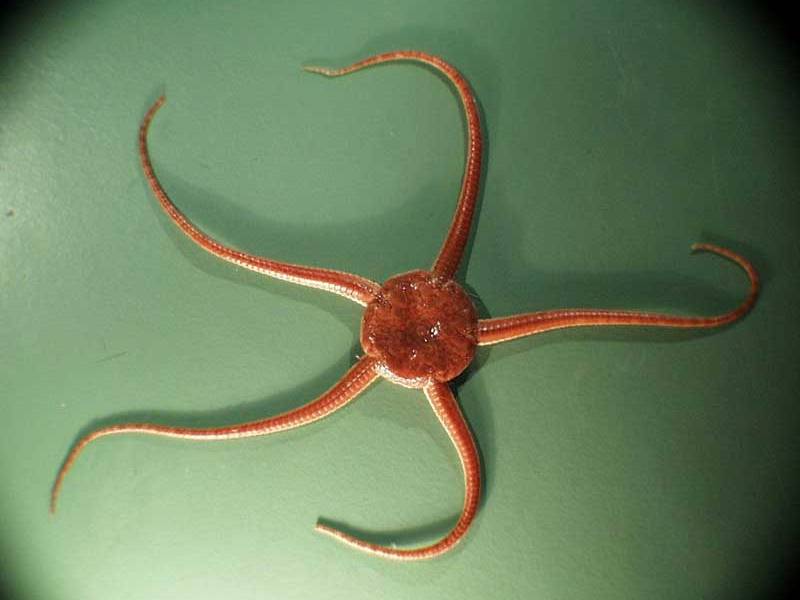Serpent star (Ophiura ophiura)
Distribution data supplied by the Ocean Biodiversity Information System (OBIS). To interrogate UK data visit the NBN Atlas.Map Help
| Researched by | Ana Ruiz | Refereed by | Admin |
| Authority | (Linnaeus, 1758) | ||
| Other common names | - | Synonyms | Ophiura texturata (Linnaeus, 1758) |
Summary
Description
A large robust brittlestar with relatively inflexible arms. The upper side of Ophiura ophiura is reddish or reddish brown in colour, often with white spots, while the underside (oral side) is white. The disc is up to about 3.5 cm in diameter and the arms are about 3.5 times as long as the diameter of the disc, up to 12 cm in length. The dorsal and ventral surfaces of the disc are covered with plates. The arms are made of articulating calcareous pieces that allow considerable twisting in the lateral plane. Ophiura ophiura can be distinguished from similar species by having pores between the ventral plates at the base of each arm and by having combs of about 30 fine papillae at each base.
Recorded distribution in Britain and Ireland
All British and Irish coasts.
Global distribution
Recorded from North Norway and Iceland, south to the Azores, Madeira and into the Mediterranean and the Black Sea, frequent in the North Sea and Scandanavian waters and into the transitional area between the North Sea and the Baltic.
Habitat
Common over sand and muddy-sand. It extends from the lower shore to depths of about 200 m.
Depth range
Lower shore to 850 mIdentifying features
- Central disc up to 3.5 cm across
- Arms 3.5 times the diameter of the disc, up to 12 cm in length.
- Upper surface of the disc with coarse scales.
- Arm spines lie almost flat against arms.
- Pair of pores between ventral plates at the base of the arms.
- Dorsal surface of disc reddish-brown, ventral side white.
Additional information
Ophiura ophiura is omnivorous, an active predator capable of capturing and/or engulfing prey, but also a scavenger and detritivore. Its diet depends on the species available but it will prey on polychaetes, crustaceans (inc. isopods, amphipods), small bivalves (e.g. Spisula, Mytrea), other ophiuroids (e.g. the arms of Ophiura albida), larvae, nematodes, meiofauna, fish fragments, diatoms, and detritus such as plant debris and organically enriched sediments (Caspers, 1980; Feder, 1981; Feder & Pearson, 1988; Boos et al., 2010).
Listed by
- none -
Bibliography
Bergmann, M. & Moore, P.G., 2001. Survival of decapod crustaceans discarded in the Nephrops fishery of the Clyde Sea area, Scotland. ICES Journal of Marine Science, 58, 163-171. DOI https://doi.org/10.1006/jmsc.2000.0999
Bergmann, M., Beare, D.J. & Moore, P.G., 2001. Damage sustained by epibentic invertebrates discarded in the Nephrops fishery of the Clyde Sea area, Scotland. Journal of Sea Research, 45, 105-118.
Boos, K., Gutow, L., Mundry, R. & Franke, H.-D., 2010. Sediment preference and burrowing behaviour in the sympatric brittlestars Ophiura albida Forbes, 1839 and Ophiura ophiura (Linnaeus, 1758) (Ophiuroidea, Echinodermata). Journal of Experimental Marine Biology and Ecology, 393 (1–2), 176-181. DOI https://doi.org/10.1016/j.jembe.2010.07.021
Caspers, H., 1980. Adaptation and biocoenotic associations of echinoderms in a sewage dumping area of the southern North Sea. A macro-scale experiment. In Echinoderms: present and past (ed. M. Jangoux), pp. 189-198. Rotterdam: Balkema.
Dahm, C., 1993. Growth, production and ecological significance of Ophiura albida and Ophiura ophiura (Echinodermata: Ophiuroidea) in the German Bight. Marine Biology, 116 (3), 431-437. DOI https://doi.org/10.1007/BF00350060
Feder, H.M. & Pearson, T.H., 1988. The benthic ecology of Loch Linnhe and Loch Eil, a sea-loch system on the west coast of Scotland. 5. Biology of the dominant soft-bottom epifauna and their interaction with the infauna. Journal of Experimental Marine Biology and Ecology, 116, 99-134. DOI https://doi.org/10.1016/0022-0981(88)90050-0
Feder, H.M., 1981. Aspects of the feeding biology of the brittle star Ophiura texturata. Ophelia, 20, 215-235. DOI https://doi.org/10.1080/00785236.1981.10426573
Fish, J.D. & Fish, S., 1996. A student's guide to the seashore. Cambridge: Cambridge University Press.
Hayward, P.J. & Ryland, J.S. (ed.) 1995b. Handbook of the marine fauna of North-West Europe. Oxford: Oxford University Press.
Howson, C.M. & Picton, B.E., 1997. The species directory of the marine fauna and flora of the British Isles and surrounding seas. Belfast: Ulster Museum. [Ulster Museum publication, no. 276.]
Mortensen, T.H., 1927. Handbook of the echinoderms of the British Isles. London: Humphrey Milford, Oxford University Press.
Picton, B.E., 1993. A field guide to the shallow-water echinoderms of the British Isles. London: Immel Publishing Ltd.
Southward, E.C. & Campbell, A.C., 2006. Echinoderms. The Linnean Society of London. Avon: The Bath Press. [Synopses of the British Fauna No. 56.]
Tyler, P.A., 1977a. Seasonal variation and ecology of gametogenesis in the genus Ophiura (Ophiuroidea: Echinodermata) from the Bristol Channel. Journal of Experimental Marine Biology and Ecology, 30, 185-197.
Ursin, E., 1960. A quantitative investigation of the echinoderm fauna of the central North Sea. Meddelelser fra Danmark Fiskeri-og-Havundersogelser, 2 (24), pp. 204.
Datasets
Centre for Environmental Data and Recording, 2018. Ulster Museum Marine Surveys of Northern Ireland Coastal Waters. Occurrence dataset https://www.nmni.com/CEDaR/CEDaR-Centre-for-Environmental-Data-and-Recording.aspx accessed via NBNAtlas.org on 2018-09-25.
Cofnod – North Wales Environmental Information Service, 2018. Miscellaneous records held on the Cofnod database. Occurrence dataset: https://doi.org/10.15468/hcgqsi accessed via GBIF.org on 2018-09-25.
Fenwick, 2018. Aphotomarine. Occurrence dataset http://www.aphotomarine.com/index.html Accessed via NBNAtlas.org on 2018-10-01
Isle of Wight Local Records Centre, 2017. IOW Natural History & Archaeological Society Marine Invertebrate Records 1853- 2011. Occurrence dataset: https://doi.org/10.15468/d9amhg accessed via GBIF.org on 2018-09-27.
Kent Wildlife Trust, 2018. Kent Wildlife Trust Shoresearch Intertidal Survey 2004 onwards. Occurrence dataset: https://www.kentwildlifetrust.org.uk/ accessed via NBNAtlas.org on 2018-10-01.
National Trust, 2017. National Trust Species Records. Occurrence dataset: https://doi.org/10.15468/opc6g1 accessed via GBIF.org on 2018-10-01.
NBN (National Biodiversity Network) Atlas. Available from: https://www.nbnatlas.org.
OBIS (Ocean Biodiversity Information System), 2024. Global map of species distribution using gridded data. Available from: Ocean Biogeographic Information System. www.iobis.org. Accessed: 2024-11-27
South East Wales Biodiversity Records Centre, 2023. SEWBReC Marine and other Aquatic Invertebrates (South East Wales). Occurrence dataset:https://doi.org/10.15468/zxy1n6 accessed via GBIF.org on 2024-09-27.
Citation
This review can be cited as:
Last Updated: 16/08/2022





